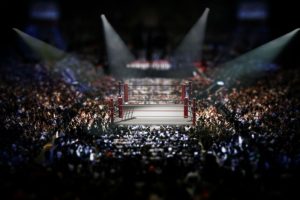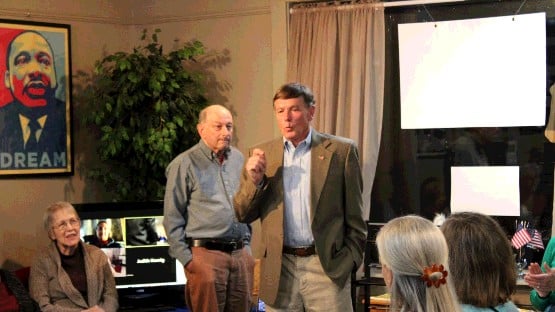
Vince McMahon grew up in a trailer park in North Carolina. His genius for marketing got him out of the trailer park and into the penthouse, and though he always seemed a bit ashamed of how he got there, it all plays together to explain how he got to where he did.
McMahon, famously, had his on-air talent avoid the words “professional wrestling,” in favor of “sports entertainment,” because “sports entertainment” doesn’t evoke the images of the early 20th century carnies who turned worked athletic wrestling competitions into a thriving business enterprise.
Whatever he wants to call it, it’s wrestling, and no matter how desperate McMahon was to get out of the trailer park, the key to understanding the Vince McMahon who turned his father’s Northeast wrestling promotion into a multibillion-dollar entertainment conglomerate is understanding trailer park Vinnie.
***
McMahon worked for his father, Vince Sr., who took him in as a 12-year-old, then promptly sent Vince Jr. to military school, Fishburne Military School in Waynesboro.
After graduating from Fishburne and then East Carolina University, McMahon ended up working for his dad’s wrestling business, World Wrestling Federation, which the younger McMahon would buy from his father in 1982 for a modest $1 million, the equivalent of $3.1 million in 2022 dollars.
McMahon was already working on changing the business model. Wrestling in the United States at that time was a patchwork of regional promotions, most under the umbrella of the National Wrestling Alliance, a cartel that recognized a single touring world champ.
McMahon Sr. had taken his WWWF (later WWF, now WWE) out from under the NWA cartel in the early 1960s, recognizing his own world champ, though he still operated within the confines of his Northeast territory, respecting the boundaries of the territory system.
McMahon Jr. wanted to go big, and began raiding rival promoters for talents like Hulk Hogan, “Rowdy” Roddy Piper, Jesse “The Body” Ventura and over the years many others, while building up a national TV presence on the still-nascent world of cable TV.
As the WWF grew in stature, the regional promoters, increasingly unable to compete, began to close up shop, and indeed by the end of the 1980s, most had gone out of business, with the main competition coming from the remnants of Jim Crockett Jr.’s Mid-Atlantic promotion, which had been purchased by billionaire TV mogul Ted Turner and rebranded as World Championship Wrestling.
Wrestling in the 1990s was defined by the rivalry between WWF and WCW, with a brief intervention by ECW, a Philadelphia-based regional promotion run by Paul Heyman, a former manager who was able to build up a cult following with a more violence-based product.
McMahon survived a trial on federal steroids peddling charges, then nearly going bankrupt when Turner threw tens of millions at Hogan and WWF stars Kevin Nash, Scott Hall and Bret Hart to buy his way to a victory in the “Monday Night Wars.”
The Wars ended on March 26, 2001, when McMahon appeared on WCW’s “Monday Nitro” to announce that he had purchased WCW, beginning an 18-year Pax Luctatio in which McMahon’s WWE reigned supreme.
***
McMahon largely homogenized pro wrestling, Disneyfied it, to borrow that term for distilling entertainment into a cleaner form deemed to be more suitable for mass consumption.
Aside from his Attitude Era that pushed the boundaries in the late 1990s, McMahon’s WWE/WWE has been built around cartoon characters like Hogan, or Marvel comic-ish characters like Roman Reigns and The Undertaker.
McMahon’s performers have always looked the part – his preference for musclemen was what almost landed him in jail in the 1990s – but rarely made anyone think “tough guy.”
It wasn’t the product that vaulted McMahon to the top of the business; it was his marketing instinct. He gambled the future of the company on the inaugural Wrestlemania in 1985, building off the talents of Hogan and Piper with celebrities Mr. T and Cyndi Lauper bringing mainstream attention.
Wrestlemania III is the event that turned the tide in the wrestling business, with the Hogan-Andre the Giant main event selling out the Pontiac Silverdome, with a reported 80,000 fans in the venue, and the show drew a reported 500,000 pay-per-view buys and another 450,000 watching on closed-circuit TV across the country.
Wrestling, to that point, had been a live-event business, the bulk of the revenues for companies being ticket sales, with TV’s role solely to promote the live dates. Now the business makes the bulk of its money, and almost all of its profits, off TV and streaming.
***
Was it all for the good of the business? Purists would argue, no. The product in McMahon’s universe is secondary to the marketing, for one, and two, the death of the territories made it hard for aspiring wrestlers to hone their craft in the bingo halls and high school gyms where the stars of yesteryear earned their bump cards before hitting the big time.
On the flip side, McMahon’s innovations have brought wrestling in front of many more sets of eyeballs than fans of the Apter mags in the 1970s and 1980s could ever have imagined. WWE has big-money contracts with Fox and NBC that are worth billions, and the company’s alumni include A-list celebrities Dwayne “The Rock” Johnson and John Cena who are known far and wide beyond the confines of the wrestling ring.
McMahon himself has that level of celebrity, ironically because he came out from behind the curtain to play a role, as the evil Mr. McMahon, the villain to the popular anti-hero, “Stone Cold” Steve Austin, in what became the defining rivalry of the WWF/WWE era.
Like McMahon, I also grew up in a trailer park, so maybe it’s with those eyes that I see how the Mr. McMahon/”Stone Cold” Steve Austin rivalry has its roots in McMahon’s upbringing.
McMahon has said in interviews that he hated the feeling that people looked down on him because he lived in a trailer park, and I think it’s that sense that came to life in “Stone Cold” Steve Austin, the beer-drinking redneck who gave it to the slicked-hair corporate suit Mr. McMahon at every opportunity.
For all the glitz and glamor that McMahon injected into his WWF/WWE to try to boost its appeal to the mainstream, it’s this basic story, the average guy sticking it to the rich guy, born in a trailer park, that was at the root of his success.










